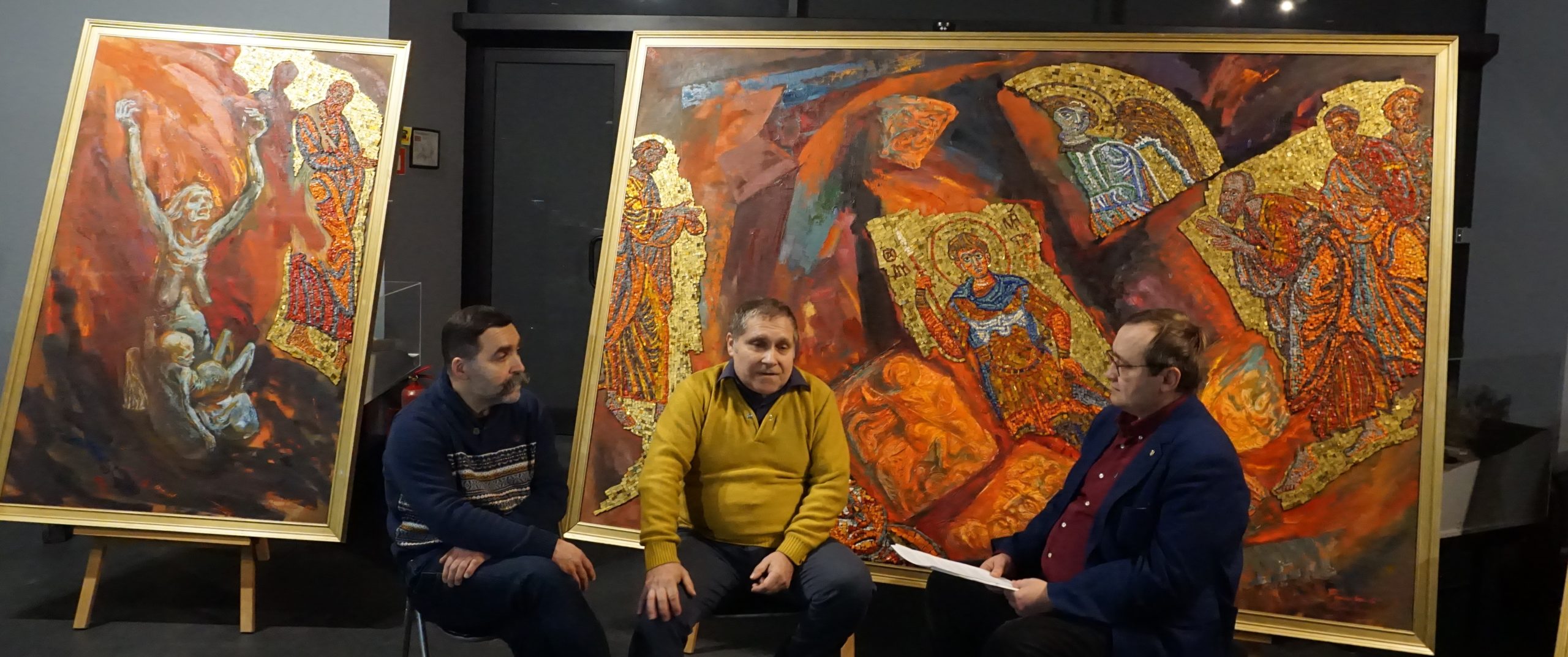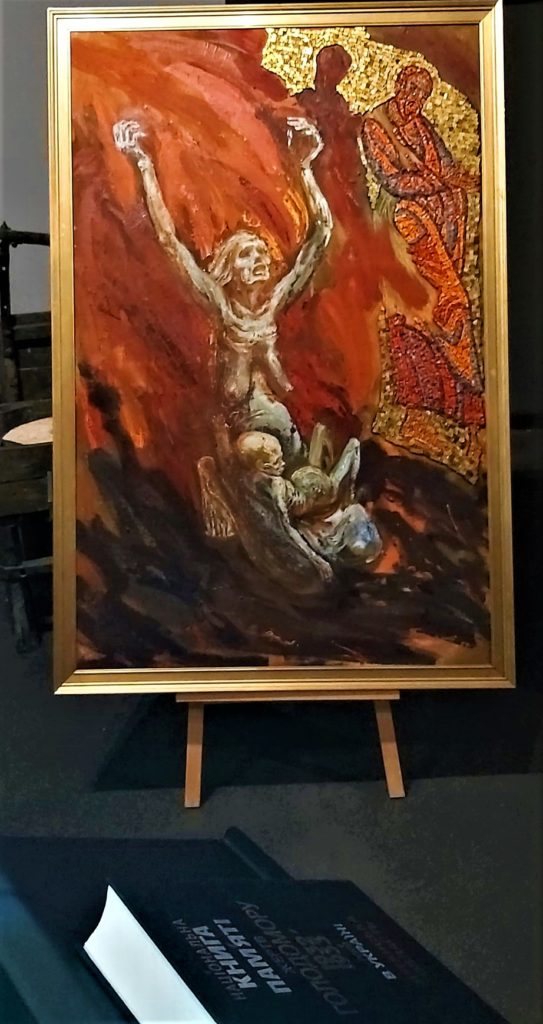“We decided to raise the topic of the Holodomor. Who else but us”: an interview with artists Yurii and Taras Honcharenko, authors of the triptych “Genocide 1933”
The communist totalitarian regime concealed the truth about one of the most terrible and large-scale crimes – the Holodomor in Ukraine in 1932-1933 – behind seven locks from both its subjects and the world public. The walls of silence and lies artificially erected by the USSR around the genocide of the Ukrainian nation only deepened the trauma inflicted on Ukrainians. Art should play a crucial role in its treatment. However, the communist authorities in Ukraine blocked this possibility for decades. With the first blows of freedom in the Soviet empire at the end of the 1980s, the Kyiv artists, the brothers Taras and Yurii Honcharenko, who come from a Ukrainian artistic dynasty, undertook to reveal the topic with art means at their own risk. The artists, despite their young age at the time, managed to create a large-scale work of fine art – a triptych with the eloquent and very bold 1989 title “Genocide 1933”. It combines a unique performance technique – a synthesis of mosaics and oil on canvas – with a deep understanding of the tragedy of Ukraine and the crime of the totalitarian empire. In the 1990s, Morgan Williams, the founder and trusted owner of the unique collection “Holodomor through the eyes of Ukrainian artists,” purchased the triptych. At the end of 2022, the triptych was transferred to the National Museum of the Holodomor-Genocide. Since January 5, it has been on display in the Hall of Memory of the museum. The museum’s leading researcher, a candidate in historical sciences, Andrii Ivanets, asked Taras and Yurii Honcharenko about the circumstances of the creation and the subsequent fate of the unique work of art.
“There was such a time when it was even dangerous to raise this topic”
A.I.:We are happy to welcome you to the Hall of Memory of the National Museum of the Holodomor-Genocide. Since January 5, we have exhibited the triptych “Genocide 1933”, which, to my mind, is one of the most symbolically expressive, artistically impressive and technically original works on the topic of the genocide of the Ukrainian people. And we are especially pleased to welcome you here because you are the authors of this triptych. Have you not seen this work for 10-15 years?
Y.H.: 15–20, it doesn’t matter. You see that there is work, and it exists, and it works and should work. Why was it created? Works are created so that they work, remind, amaze people and work for people, so that people know what happened in history.
T.H.: When we painted this painting, we did not even dream it would be exhibited somewhere in a museum, especially in our Kyiv museum.
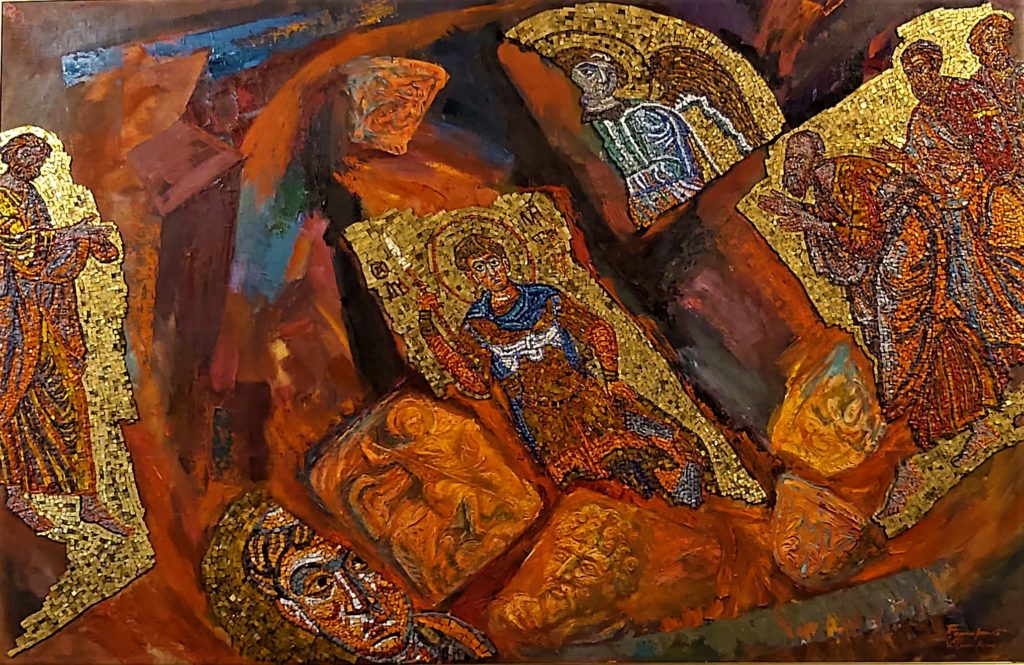
The central part of the triptych “Genocide 1933”. Photo by A. Ivanets.
A.I.: Please tell us how you worked on this painting, how long it took, and how you interacted in general. It is worth noting what the artistic value of the work is and the peculiarity of the technique of its creation. You have combined painting and mosaic, which gives a special effect of tension. How did it happen? How did you come up with the idea of creating a work on the genocide topic of the Ukrainian people?
T.H.: It was 1988. We started working on this work. I studied in graduate school with Academician Mykhailo Hordiyovych Derehus and my brother – in senior courses at the Art Institute of the Academy of Arts. He was graduating from the monumental workshop.
A.I.: Who first came up with the idea to create a work?
Y.H.: Taras, as the elder, had an idea. Although it came, of course, from our grandfather, great-grandmother, and upbringing in a family. They talked about those terrible times. It was the Soviet Union. Somewhere there was a reconstruction. There were such times when it was even dangerous to raise this topic. When we exhibited the work, we thought we would not get away with it.
A.I.: When you conceived the picture, the authorities announced for the first time that there was a famine, not a food crisis. However, it was explained by natural causes, and you showed it from the other side. When did you come up with the name Genocide 1933?
T.H.: There was a rather complicated story. Our grandfather worked on the subject of barbarism. He conceived it as a symbol of what was done to our culture, our people, and our history by the Soviet regime. Such a small sketch has survived: it is 15-20 centimetres, made in the applique technique. A work of genius. Yura and I had the idea to make this work in the Florentine mosaic technique…. A cross-section of the stone is made, the colour is selected, and semi-precious stones give an effect that cannot be predicted. This is how we want to reproduce our grandfather’s work, to make a monumental thing based on his sketch. This is still our dream, maybe we will do it someday.
A.I.: Let us clarify that your grandfather is Volodymyr Bondarenko, a well-known artist of his time and Mykhailo Boychuk and Fedir Krychevskyi’s student.
T.H.: He was a painter. He could not exhibit his easel paintings. After long persecution, he was able to reveal his creative potential in monumental art, he was the deputy head of the monumental art section of the Union of Artists. And this sketch of grandfather’s work was kept.
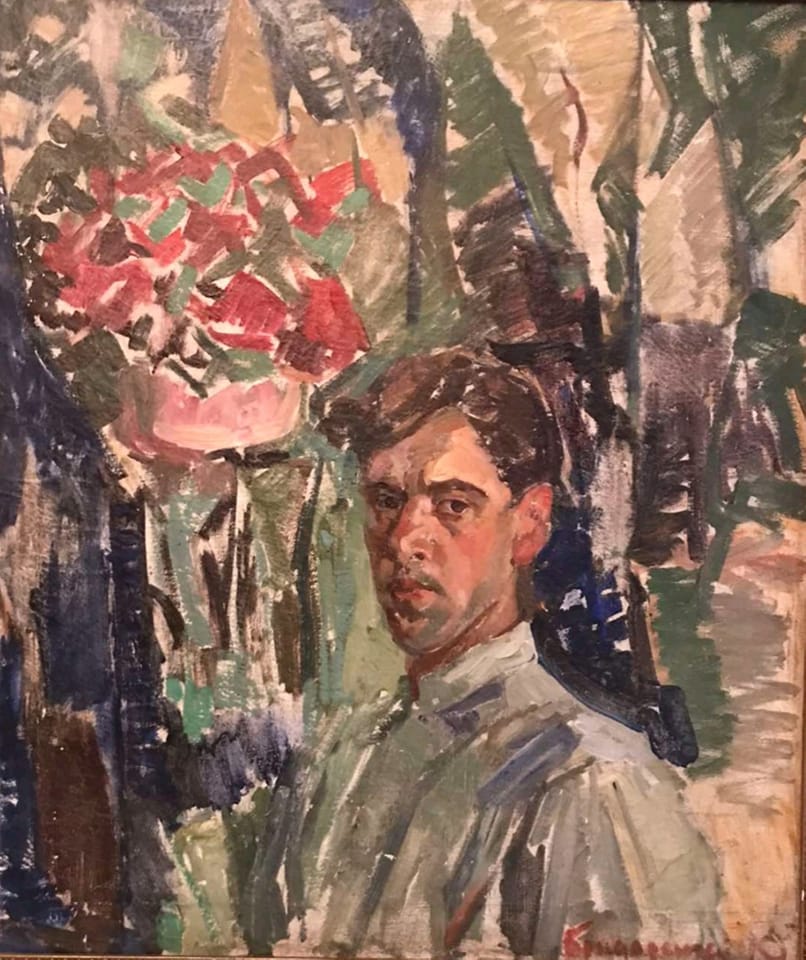
Self portrait. Volodymyr Bondarenko. 1947. Painting from Y. Honcharenko’s family archive.
Y.H.: And we dream of realizing his plan.
A.I.: Your grandfather died in 1980. And your family kept this sketch from stagnant times. In the last years of his life, my grandfather worked on this idea. It became an impetus for you, and then you suggested to your brother: come on, let’s do something different.
Y.H..: We decided to raise the topic of the Holodomor. Who else but us? It is our idea. The impetus was my grandfather’s work but we were implementing our idea.
T.H.: The idea of smalta arose organically because I helped my grandfather as a child, and my brother studied in a monumental workshop, studying the mosaic technique. My grandfather had boxes of smalt from his monumental works. He also restored Sophia of Kyiv. From there he had a golden mosaic.
A.I.: So the grandfather’s mosaic was used to create the painting?
T.H.: Grandpa’s mosaic, which remained with him from his works. The technology itself, how to glue smalt on canvas, came from technologies developed by our grandfather’s student, Volodymyr Melnyk, who studied at the art school. I will say a few words about this time. Volodymyr Melnyk was not able to study or get a higher education. He only finished art school, and not completely because his grandfather was persecuted, fired from his job at the end of the 1940s, and his entire class was expelled from school. The boys were sent to the navy for 8 years, and almost none of them continued their studies. The girls returned to school, and entered the institute, among them are the famous artists Alla Horska, and Halyna Zubchenko. That was such a time. So Volodymyr Melnyk worked as a craftsman in an art workshop in a monumental workshop and developed techniques.
A.I.: So was the very technology of combining painting and mosaic techniques developed by Volodymyr Melnyk?
T.H.: He developed various technologies, how to work with smalt, restored the encaustic technique, and others. He shared his designs with many artists. Volodymyr Melnyk passed on many things to us. According to his designs, artists worked at the Golden Gate metro station. A developed technique when the mosaic is transferred to the wall in large blocks.
Y.H.: Our grandfather also paid a lot of attention to technology, he had many works in Kyiv. By the way, I saw how the one was removed from the wall of a store in Khreschatyk and taken to a museum. I saw a restorer we know carrying my grandfather’s work across the street. The glued canvas was so good, that it was removed with pieces of wall and plaster.
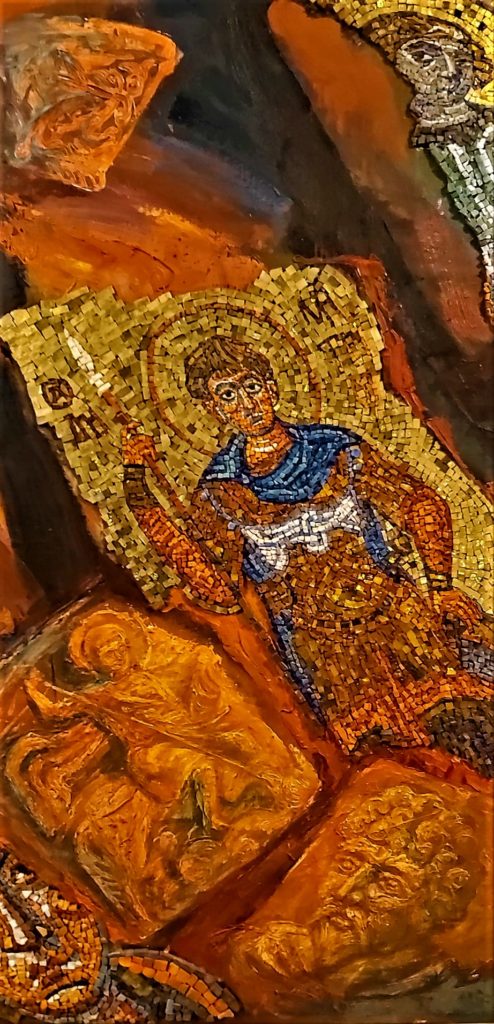
A fragment of the central part of the triptych is the “Dmytro Solunsky” mosaic. This image of the saint was in St. Michael’s Cathedral before its destruction by the Bolsheviks, and at the end of the 1930s, the mosaic was taken from Kyiv to Moscow. Photo by A. Ivanets.
A.I.: If we revert to our triptych, do you remember the month when you started working on it in 1988?
Y.H.: Either from March or April.
A.I.: You worked from the spring of 1988. And when did the working end? I understand that both of you worked on all parts of the triptych.
T.H.: In the summer of 1989, we completed work on the triptych.
Y.H.: It’s nice to have a brother! We ordered tablets together and screwed them to the trunk… It is not easy to carry, lift, or rotate such work with smalt during work. You work mainly in a horizontal position when the glue catches and fixes the smalt; you lift the tablet vertically to see what is done. It was much easier to work together.
A.I.: The foundation is heavy, right?
T.H.: Well, that time, we were stronger, so we could do it like this: we took it and carried it.
“We showed the triptych to my teacher Mykhailo Derehus, he was shocked”
A.I.: In the summer of 1989, you finished the work. And that time you gave it the name “Genocide 1933”.
T. H.: We thought about “Holodomor-genocide”. There were different options. We started with our grandfather’s “Barbarism”.
A.I.: Did your grandfather have that sketch?
T.H.: Yes, he did! We knew about our grandfather’s plan. He talked a lot about his future work. He nurtured this idea for several years. He worked on sketches. The work had to be colossal in composition and colour.

Triptych “Genocide 1933” in the Hall of Memory of the National Museum of the Holodomor-Genocide. Photo by A. Ivanets.
A.I.: You finished the triptych “Genocide 1933” in the summer of 1989. What happened next? Where did you show it to people for the first time?
T.H.: First, our parents saw it. Father said that it should be called shortly “Genocide”. Before that, there had been the work of “Scythians”. Therefore, this was already the second big joint work. Then, we showed the triptych to my teacher Mykhailo Derehus, and he was shocked. He did not expect such work. He said to show it to Mykola Zhulynskyi, who was then the director of the Institute of Literature. We went and got to know each other. We showed the photos. Later, he came and looked at the work. This topic was also close to him. He was amazed that this topic was raised by someone at that time. And in principle, he later helped Yurko with his diploma. Yurko had a diploma work dedicated to repressed Ukrainian writers. And Mykola Hryhorovych gave a book published in Canada. It is a well-known study about destroyed Ukrainian artists.
By the way, about this book. Our grandfather once bought a photocopy of this book on the black market, where it was slipped to him by a KGB agent. It was a very small photocopy. I have already begun to say that my grandfather was basically persecuted all the time. One of the provocations was as follows: they slipped him this photocopy booklet. The KGB expected that somewhere like that he would read it in a couple of weeks and give it to one of his friends, which is the distribution of anti-Soviet literature. Ten years. They did not manage to put him in jail there, so it would be something like this. My grandfather did not finish reading the book because it was very hard due to its small size. And it stayed with him. And later, they came with a search. Grandfather gave it away himself. He still had such books. They could find Solzhenitsyn and others if they looked for.
A.I.:Was it after 1944, when he became a member of the Union of Artists of Ukraine and started working at the Kyiv Art School, that they started persecuting him?
T.H.: They could have. But they began persecuting in 1948. The fact is that there was a story then too. Our grandfather was in a German concentration camp, and he was surrounded and wounded — captured. He was in the German occupation. When the Red Army occupied Kyiv, Oleksandr Dovzhenko gathered the “liberated” intelligentsia, who would probably be sent to the camps, and during the First Ukrainian Front, he organized artists, actors, and creative intelligentsia into front brigades. My grandfather was in the artists’ brigade. He had several exhibitions – an international exhibition in Vienna and one in Prague. He started an artistic career well after the war and taught at an art school. When the Art Institute returned from evacuation, the functionaries returned. And, here is a talented artist with exhibitions, plus a Ukrainian, plus envy. Also, they persecuted our grandfather for sheltering an “enemy of the people.” After the war, Fedir Krychevskyi lived at our home when he returned from Austria seriously ill after a stomach operation. He was our grandfather’s teacher. His colleagues occupied the apartment and the workshop. They didn’t even let him into the apartment. Natalia Pavlivna (the artist’s wife) often mentioned the white grand piano that had remained there. And, Mykyta Khrushchev said: “Fedir, don’t come to me anymore!” Our grandfather took the teacher with his wife and his works to his place from the boxcar at the station.
A.I.: I think it will be necessary to talk about your grandfather separately, this is a capturing topic.
Y.H.: Grandfather was persecuted for this. He started out very strong, so strong, his easel works of the 40s are the best. Luckily, they survived.
“It was a terrible time of destruction of culture and people”
A.I.: I have a question for you both. The viewer is believed to be partly a co-creator of the artwork. Your painting fascinates me and many others because you managed to depict genocide in a broad sense. We see here the Holodomor itself, a mother with raised hands and a dying swollen child; we see a crucified man who can be perceived as someone who is being repressed, and destroyed; we see a destroyed temple and this flame as the destruction of religion. And all this is symbolically shown by the Genocide of Ukrainians in the 1930s. This is clearly read by the viewer. So, when you worked on the triptych, what meanings did you put into it?
Y.H.: These meanings were put into it. The reason we were talking about our grandfather is that it was a search. He had thoughts about his work. It was a search. We tried to create an image of those events, the destruction of culture and people, a terrible time. The same what is happening now.
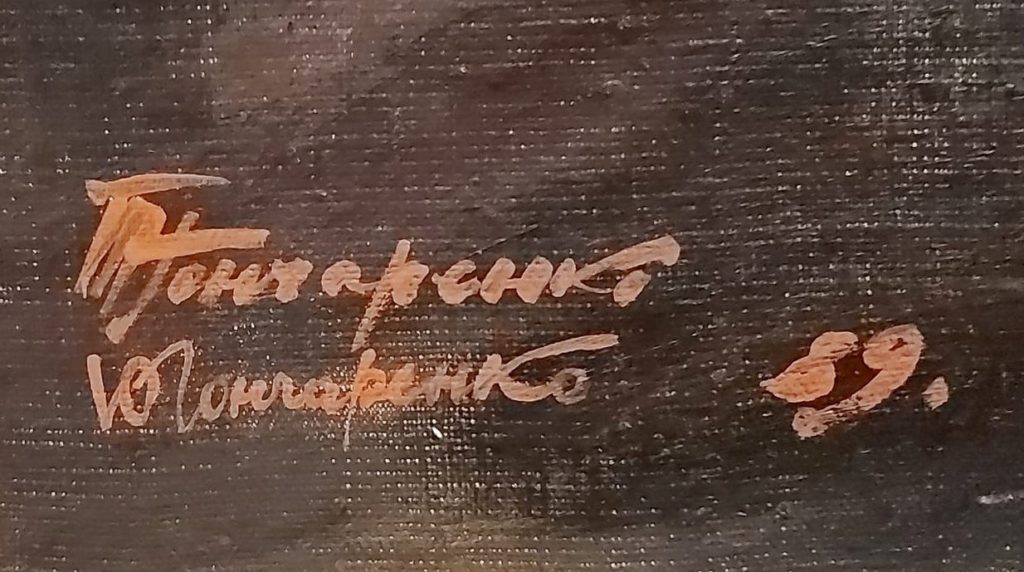
Author’s signatures on one of the paintings of the triptych.
A.I.: How do you define the style of a triptych?
T.H.: It really turned out to be such a monumental work, and the techniques are combined, which, at first glance, could never be combined.
A.I.: I cannot think of analogues where smalta and painting were combined in art…
Y.H.: There are almost none of them.
A.I.: So in this sense, is it unique?
Y.H.: Maybe.
T.H.: We decided together which technique to choose for our work. After all, since we were children, we saw how our grandfather and parents worked with these techniques. The difficulty was how to combine smalt and oil painting. To be sure that the smalt will hold firmly, how the oil paint will show itself next to it? Yurko studied the technique of classic smalt mosaic at the Art Institute, and I directly from my grandfather, communicating with and helping him. That’s when I learned the secrets of laying smalt in Sofia of Kyiv. My grandfather restored those mosaics, saw the ancient masters’ skills and used their secrets in his mosaic works.
Y.H.: Something led us to this work.
T.H.: Somehow it was delayed when I learnt. Yurko also went to this idea in his own ways. I saw him working at the institute in various monumental techniques. Previous joint work with my brother led us to this idea.
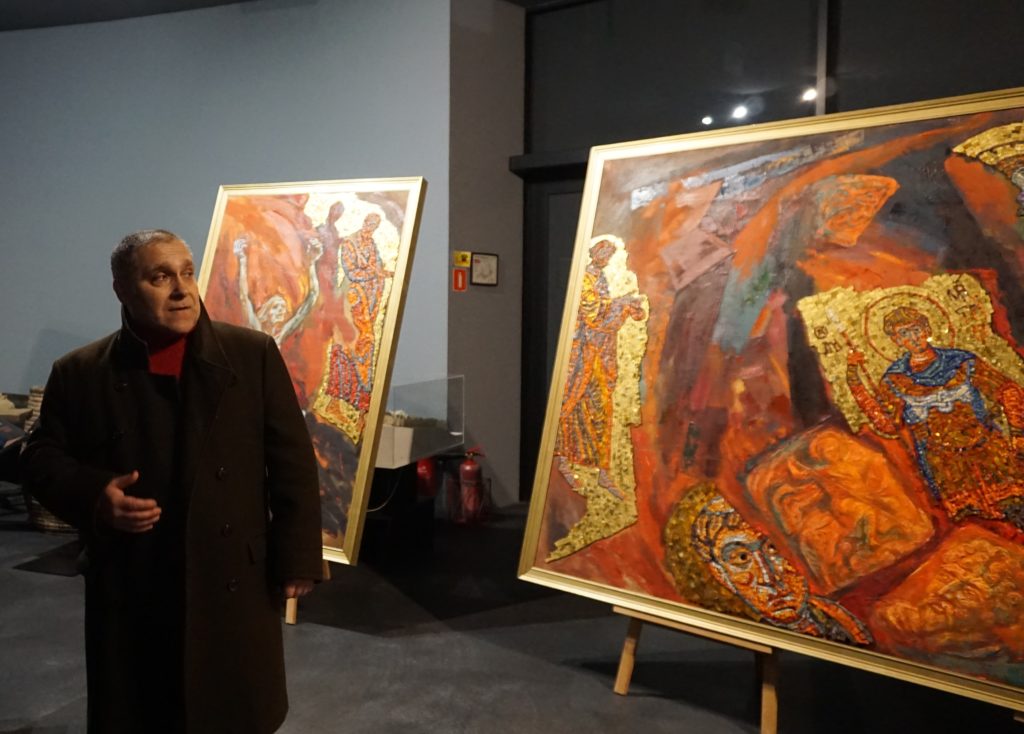
Taras Honcharenko near his work at the Holodomor Museum.
“When Alla Horska was killed, grandfather came and asked father for vodka”
A.I.: In post-Soviet Ukraine, you were one of the first who started talking about the Holodomor through painting. But, at that time, there were already quite interesting works in the diaspora. The catastrophe of the early 1930s deeply shook the life of the Ukrainian people. It could not but find a response in the artists’ souls. When in Soviet Ukraine, attempts to talk about it were suppressed, and the authorities repressed mentions of the Holodomor, the Ukrainians in the free world could speak more freely. And we know such works. Viktor Tsymbal, a famous artist and veteran of the UNR army, following in hot pursuit, presented the symbolic painting “Hunger of 1933” to the public. We know about the large-scale canvas “Calvary of Ukraine” by Petro Andrusiv, which, regretfully, was destroyed during the Second World War. These two works, created in the 1930s, are thematically similar to yours. At that time, did you know any works of the diaspora on the Holodomor topic?
T.H.: Of course, we did not know about the paintings of the diaspora because everything was hidden. But we were familiar with works of world art. On the topic of hunger, for example, its reflection in an emotionally powerful linocut by Kathe Kollwitz dedicated to famine in the 1920s. The image of the crucifixion is also a reminiscence of world art.
In Ukraine, many artists were destroyed in the 1930s during repressions and the Holodomor, whose works we will never be able to know. Whole types of fine art were destroyed, like Mykhailo Boychuk and his school.
In the 1960s, there was also a powerful protest movement, which the totalitarian government fought with inhumane means that were intended to intimidate people… The destroyed stained glass window of Alla Horska at Kyiv University and other things.I remember when Alla Horska was killed (on November 28, 1970, the “soul of the dissident movement” in Ukraine was killed, probably by the KGB, but her father-in-law was blamed, whose body was found on the railway tracks soon – A.I.), grandfather came to us. He told us all this, the whole story. Now everyone knows her. He came, saying to our father: “Sit down, pour me some vodka.” And my grandfather never drank. He just came in shock.
The left part of the triptych “Genocide 1933”. A mother with a swollen child on her lap is crying out to heaven. Photo by A. Ivanets.
A.I.: And did he continue communicating with the artist and dissident Alla Horska in the 1960s?
T.H.:Of course, he talked to her all the time. It was his favourite class, she was his favourite student. Everything is very interconnected. All this is reflected in our works. There is nothing surprising that there are some parallels, some connections, even at this level. And why did the persecution begin? They signed a letter in defence of repressed people who were imprisoned. It was 1968. And Alla Horska, Halia Zubchenko, and Liudmyla Semykina came to our grandfather and brought that letter and asked him to sign it. The grandfather did not sign that letter and persuaded them not to sign it either. The grandfather said there was no “thaw”, and the Soviet government had not changed since the 1930s, so that could be a provocation by the KGB. I have already told you the story a little. Our grandfather had such an experience there. In a word, the grandfather did not sign because he wanted to protect them. He refused and said that if they saw his signature, lots of friends would sign it and could be hurt. Perhaps, it was not a provocation. It was really a rush of youth. But there were obvious risks. Our grandfather just understood how it could end. And he just wanted to save them. Youth is youth.
A.I.: I see that your grandfather, Volodymyr Bondarenko, played a crucial role in your formation. He gave an impetus to the artistic work and, at the same time, gave you the direction of understanding national history. I think that ordinary Soviet children could not simply get access to such information. And you have already said that grandfather was one of the first to tell you about the Holodomor.
Y.H.: Our great-grandma. She was more involved in our upbringing. Oleksandra Tarasivna, grandfather’s mother.
A.I.: And where did she live during the Holodomor?
Y.H.: Our grandfather graduated from the Art Institute twice – before and after the reorganization. The great-grandmother generally lived in Odessa. She dreamed of being a singer. She studied at the Odessa Opera. She sang there and planned a career. But revolutions began. When the Reds captured Odesa, she was imprisoned by the Cheka. She stayed there for 11 months. She was transferred to Kharkiv. There were such terrible things, in fact, genocide, that the Soviet government itself had to conduct a military operation. All those who were in prison and remained alive were transferred to Kharkiv. The great-grandmother was released, and she moved to Kyiv and took our grandfather and her sister. They lived on Dmytrivska Street, near the circus. Our great-grandmother had her own business in Yevbaz (Jewish market). She did not work for the Soviet authorities after seeing all that horror.
A.I.: Did she trade something?
T.H.: Yes, she did, with her sister. And our grandfather sang and drew very well. She dreamed of him being a singer. She didn’t want him to be an artist. Our grandfather entered the conservatory and studied at the art institute simultaneously. Around a year later, the law passed that one could not study at two institutes at the same time, so our grandfather stayed at the Artistic one.
A.I.: Did your great-grandmother experience the Holodomor in Kyiv?
T.H.: Yes, she did. And she saved family and friends…
A.I.: What did she tell you about it? When did she tell you?
T.H.: She told us in the mid-1960s when we were still little, she told the truth. Even when she was peeling potatoes, she showed how to peel them thinly or how to cut them into pieces and plant potatoes so that they would grow more. She was mainly involved in our upbringing. She warned us not to talk about it in kindergarten and at school. She told about all the horror that was happening during the Holodomor organized in the USSR and during the wars. She told us how terrible it is and how to save people dying of hunger…
A.I.: If we return to our triptych, this is your creative idea, but your grandfather encouraged you, and your father helped you with the name. Then you showed it to your teacher Mykhailo Derehus, and after that, Mykola Zhulynsky saw it. But these were exclusive demonstrations of the triptych. And when was a wider audience able to see this work?
T.H.: In 1989 we presented our work at the exhibition. It was a Republican exhibition, and what’s more, it was so Soviet. And we didn’t think it would pass. To show it there to be seen by the admission committee and the artists who brought their work. And at that time, there was the first exhibition in which everyone was allowed to watch how the committee works. All the artists watched our work being brought in. And all the committee voted, except the chairman because he was scared. And in general, then, he ordered them to hide the painting and not let it be on a display. Yurko managed to find it because the workers of the Union of Artists who hid it, told him. There was no more room in the exhibition hall because an exposition was created. The workers suggested where we could hang our work on the first floor near the stairs leading to the exhibition halls. And it so happened that our work opened the exhibition. Then the leadership of the Union of Artists closed the main entrance and let visitors through the side entrance so that they could not see our triptych. And many more adventures…
A.I.: Which premises was it in?
Y.H.: In the Artist’s House.
Y.H.: Then it was once again exhibited at the Union of Artists sometime in the 1990s. The exhibition was devoted to the topic of the Holodomor. By the way, the head of the Union of Artists, who ordered to hide our triptych, also created a work on the theme of the Holodomor for that exhibition, although, before that, he painted Lenin.
A.I.: Did this story pass without any consequences for you?
T.H.: No consequences. But it had its voice. Mykola Zhulynsky wanted to help the Ministry of Culture buy this work. He told us how it all happened. When the ministry came to purchase this work from the Union of Artists, experts said that there was no sense in buying this work because the smalt would fall off in a month. The Ministry of Culture was afraid of purchasing a work, from which smalt would fall down. He didn’t buy it. But smalta, you see, holds.
Y.H.: And, the Patriarch of Kyiv and All Rus’-Ukraine Filaret liked the triptych very much.
A.I.: Which exhibition did he attend?
T.H.: During the exhibition dedicated to the Holodomor, an event, perhaps a conference, was held. Filaret was there, and we invited him and showed him this work. He liked it too. Mykola Hryhorovych introduced us to James Mace.
A.I.: How did he react to this work?
Y.H.: James Mace first reacted to it, and then, he wanted to meet us.
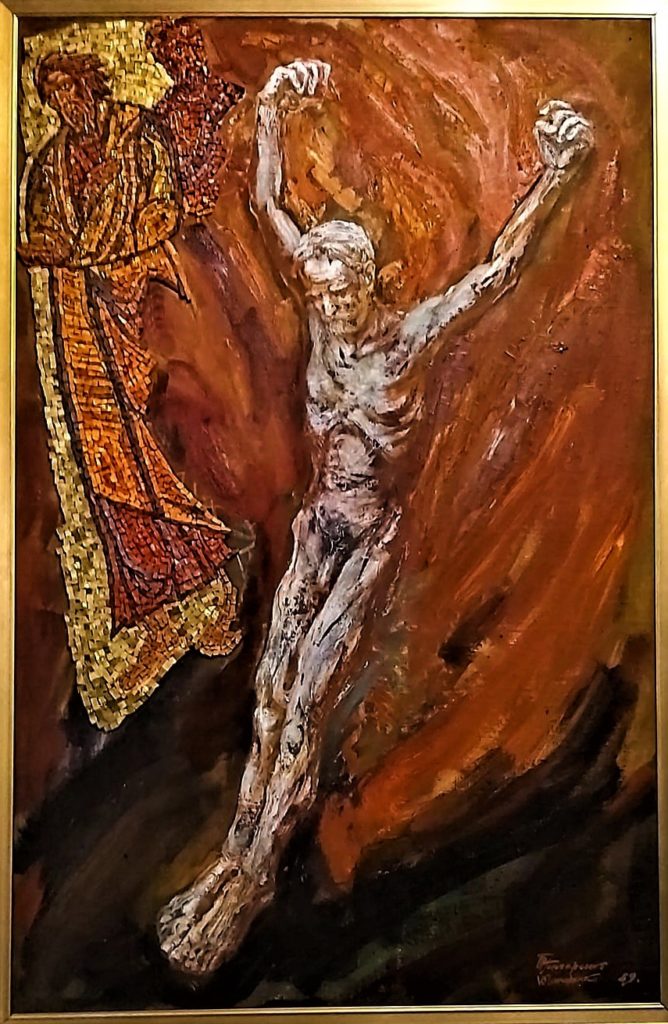
The right part of the triptych “Genocide 1933”. Photo by A. Ivanets.
A.I.: You were in your early twenties then, but the work looks mature.
T.H: In 1989, when we created the triptych “Genocide 1933”, we were 25 and 27 years old. And a year later, Yura defended his diploma thesis in technology, which was developed by Volodymyr Melnyk. It is a four-metre piece – “Great Martyrs of the Word”. If I’m not mistaken, NAVAA (the former Kyiv State Art Institute) handed it over to Kiev Higher Engineering Radio Engineering School of Air Defense for exhibition. It was also an event. The graduates of this school cover our sky now.
“We were not going to fit into the system”
A.I: I am curious to know how the triptych “Genocide 1933” ended up in the Morgan Williams collection.
Y.H.: It is even a detective story. One of the most famous Kyiv galleries decided to sell this work. There was a staff member who wanted to embezzle money for selling our work to Morgan Williams. Morgan Williams met us and told us that he had bought our work and named the amount. We came to the gallery, but there was no money. We were told that they had fired a dishonest employee who had stolen our painting and changed apartments. They could not find him. Stormy 90s! The two of us very quickly found this employee, who had been paying for his new apartment for several months, with a large percentage of our money, which he had deposited in his bank account and kept our triptych. My brother and I got the money, and Morgan Williams got our painting.
A.I.: This is a “classic” story of the 90s.
T.H.: There was one more. Morgan Williams found out about our grandfather and wanted to buy his work. He called us, and we agreed to meet in the workshop. We thought that Morgan wanted to buy our work. It turned out that he came for our grandfather’s work. With his secretary. He said he wanted to buy our grandfather’s most nationalist, anti-Soviet work. Our grandfather was not an anti-Soviet artist. My brother and I played a little joke on Morgan Williams. We took grandfather’s gorgeous piece of a nude model, a work of genius. We showed it. It is a 1944 work. Morgan Williams looked at it and said that if he had been an artist, he would have only written such works. We showed him our grandfather’s works. They were not suitable for his collection, but he saw what a master our grandfather was.
A.I.: For a long time, the USSR authorities just forbade talking about the Holodomor. For decades, it had been a real danger to life, health, and freedom. Many were afraid to raise this topic at all. Now, regretfully, in the temporarily occupied territories of Ukraine, it is dangerous to raise this topic again. Today, the occupiers are destroying museums, monuments to the Holodomor and victims of repression. On the other hand, in the free territory of Ukraine, some artists also do not dare to take on such a topic as the Holodomor since it is traumatic and very difficult. You took this topic several decades ago. Do you think artists’ treatment of this topic can help society overcome the post-genocide state? The fact that a hostile communist totalitarian empire centred in Moscow committed genocide against Ukrainians. This resonates with us almost to this day. Art can also play a role in overcoming the trauma of genocide. This issue has become relevant for us today because we are experiencing a new genocide committed by the Russian Federation. What do you think is the role of art in speaking about such topics?
T.H.: Both during and after the war, this topic will be raised. There will be craftsmen who will work. I am sure that our cinematography will develop, and historical films dedicated to the war will be made at a high level. Art is never apart from life. It is part of it, a part of life. It is at first glance that the artists are detached. We all live in this country. We all worry. Someone is fighting. Someone is helping the military. I think we will win and there will be a lot of paintings. We have many artists, young talented ones, older artists experienced. Such events now will give an impetus to study history.
A.I.: We can see now that more than 90% of Ukrainians understand that the Holodomor was a genocide.
Y.H.: If anyone had doubts before, today everyone realizes who survived, who remembers this Holodomor and told it to their children and descendants. The victims were colossal: so many people were not born, and so many died. I would not say it was a topic they were afraid to talk about. Our familiar artists, relatives, parents’ friends, our friends, everyone knew. Probably, those who did not experience it and did not receive true, information doubted that it was so.
In 1989, before his death, my grandfather talked about survival in 1932-1933, and I did not understand the scale of the disaster and crime at that time.
T.H.: Different situations. It is clear that the propaganda worked. They intimidated people and specifically destroyed them. It was crucial for us to convey such things as justice, honesty, and humanity to society. We were not going to fit into the system.
A.I.: I want to thank Mr Taras and Mr Yury Honcharenko. These are the creators of this triptych, which is behind us, one of the first in Soviet Ukraine, which is dedicated to the Holodomor topic, the genocide of the Ukrainian nation. In general, this work is pioneering in many ways, with its technique, with its symbolic sound, and we are pleased that it can be seen in such a place as the Hall of Memory of the National Museum of the Holodomor-Genocide. This place is also special. We invite those who see and hear us to come here. This valuable piece of art will be on display until February 26. We invite everyone! And thank you!
T.H., Y.H.: Likewise!
